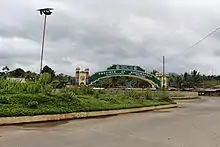Matanog
Matanog, officially the Municipality of Matanog (Iranun and Mëranaw: Ingëd a Matanog; Filipino: Bayan ng Matanog; Arabic: بلدية ماتانوج) , is a 4th class municipality in the province of Maguindanao del Norte, Philippines. According to the 2020 census, it has a population of 36,034 people.[3]
Matanog
Ingëd a Matanog Bayan ng Matanog ماتانوج | |
|---|---|
| Municipality of Matanog | |
 Poblacion of Matanog | |
 Seal | |
 Map of Maguindanao del Norte with Matanog highlighted | |
OpenStreetMap | |
.svg.png.webp) Matanog Location within the Philippines | |
| Coordinates: 7°28′N 124°15′E | |
| Country | Philippines |
| Region | Bangsamoro Autonomous Region in Muslim Mindanao |
| Province | Maguindanao del Norte |
| District | Lone district |
| Founded | August 25, 1975 |
| Barangays | 8 (see Barangays) |
| Government | |
| • Type | Sangguniang Bayan |
| • Mayor | Zohria S. Bansil-Guro |
| • Vice Mayor | Sanaira I. Ali |
| • Representative | Sittie Shahara "Dimple" I. Mastura |
| • Municipal Council | Members |
| • Electorate | 19,592 voters (2022) |
| Area | |
| • Total | 146.50 km2 (56.56 sq mi) |
| Elevation | 328 m (1,076 ft) |
| Highest elevation | 1,064 m (3,491 ft) |
| Lowest elevation | 7 m (23 ft) |
| Population (2020 census)[3] | |
| • Total | 36,034 |
| • Density | 250/km2 (640/sq mi) |
| • Households | 5,711 |
| Economy | |
| • Income class | 4th municipal income class |
| • Poverty incidence | 64.66 |
| • Revenue | ₱ 132.3 million (2020) |
| • Assets | ₱ 441.9 million (2020) |
| • Expenditure | ₱ 105.4 million (2020) |
| • Liabilities | ₱ 353.5 million (2020) |
| Service provider | |
| • Electricity | Maguindanao Electric Cooperative (MAGELCO) |
| Time zone | UTC+8 (PST) |
| ZIP code | 9613 |
| PSGC | |
| IDD : area code | +63 (0)64 |
| Native languages | Maguindanao Maranao Tagalog |
| Website | www |
Matanog was created by virtue of Presidential Decree No. 780 signed by then President Ferdinand Marcos on August 25, 1975.[5] It was carved from the municipality of Parang.
The town was part of the province of Shariff Kabunsuan from October 2006 until its nullification by the Supreme Court in July 2008.
Geography
Barangays

Matanog is politically subdivided into 8 barangays. Each barangay consists of puroks while some have sitios.
- Bayanga Norte
- Bayanga Sur
- Bugasan Norte
- Bugasan Sur (Poblacion)
- Kidama
- Sapad
- Langco
- Langkong
Climate
| Climate data for Matanog, Maguindanao | |||||||||||||
|---|---|---|---|---|---|---|---|---|---|---|---|---|---|
| Month | Jan | Feb | Mar | Apr | May | Jun | Jul | Aug | Sep | Oct | Nov | Dec | Year |
| Average high °C (°F) | 28 (82) |
28 (82) |
28 (82) |
29 (84) |
28 (82) |
27 (81) |
27 (81) |
27 (81) |
27 (81) |
27 (81) |
27 (81) |
28 (82) |
28 (82) |
| Average low °C (°F) | 22 (72) |
22 (72) |
22 (72) |
23 (73) |
23 (73) |
23 (73) |
22 (72) |
22 (72) |
22 (72) |
22 (72) |
23 (73) |
22 (72) |
22 (72) |
| Average precipitation mm (inches) | 236 (9.3) |
225 (8.9) |
244 (9.6) |
235 (9.3) |
304 (12.0) |
287 (11.3) |
200 (7.9) |
175 (6.9) |
158 (6.2) |
200 (7.9) |
287 (11.3) |
243 (9.6) |
2,794 (110.2) |
| Average rainy days | 24.3 | 22.3 | 26.0 | 27.2 | 28.3 | 27.2 | 25.8 | 24.8 | 22.2 | 25.4 | 27.2 | 25.8 | 306.5 |
| Source: Meteoblue (modeled/calculated data, not measured locally)[6] | |||||||||||||
Demographics
| Year | Pop. | ±% p.a. |
|---|---|---|
| 1980 | 8,300 | — |
| 1990 | 14,759 | +5.93% |
| 1995 | 16,018 | +1.55% |
| 2000 | 19,006 | +3.73% |
| 2007 | 36,319 | +9.34% |
| 2010 | 23,269 | −14.96% |
| 2015 | 29,770 | +4.80% |
| 2020 | 36,034 | +3.83% |
| Source: Philippine Statistics Authority[7][8][9] | ||
Economy
Gross Domestic Product The Gross Domestic Product of the Municipality (2022) is 9,128,700,000(PHP).
References
- Municipality of Matanog | (DILG)
- "2015 Census of Population, Report No. 3 – Population, Land Area, and Population Density" (PDF). Philippine Statistics Authority. Quezon City, Philippines. August 2016. ISSN 0117-1453. Archived (PDF) from the original on May 25, 2021. Retrieved July 16, 2021.
- Census of Population (2020). "Bangsamoro (BARMM)". Total Population by Province, City, Municipality and Barangay. Philippine Statistics Authority. Retrieved 8 July 2021.
- "PSA Releases the 2018 Municipal and City Level Poverty Estimates". Philippine Statistics Authority. 15 December 2021. Retrieved 22 January 2022.
- "Presidential Decree No. 780, s. 1975 | GOVPH".
- "Matanog, Maguindanao : Average Temperatures and Rainfall". Meteoblue. Retrieved 19 January 2019.
- Census of Population (2015). "ARMM – Autonomous Region in Muslim Mindanao". Total Population by Province, City, Municipality and Barangay. Philippine Statistics Authority. Retrieved 20 June 2016.
- Census of Population and Housing (2010). "ARMM – Autonomous Region in Muslim Mindanao" (PDF). Total Population by Province, City, Municipality and Barangay. National Statistics Office. Retrieved 29 June 2016.
- Censuses of Population (1903–2007). "ARMM – Autonomous Region in Muslim Mindanao". Table 1. Population Enumerated in Various Censuses by Province/Highly Urbanized City: 1903 to 2007. National Statistics Office.